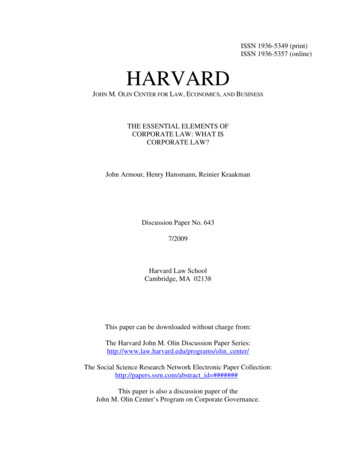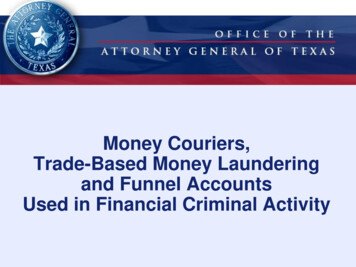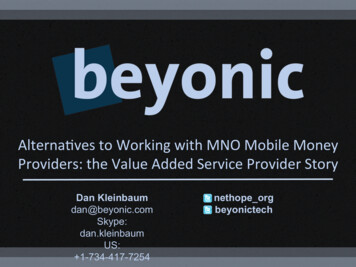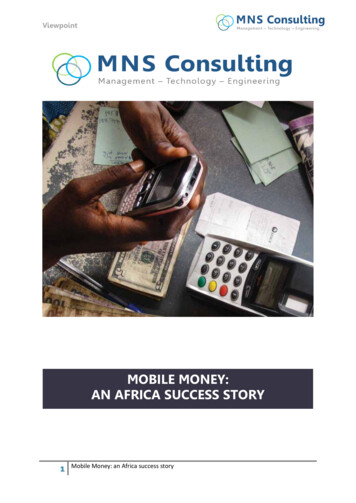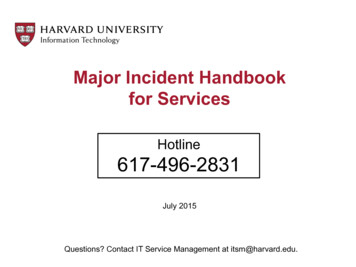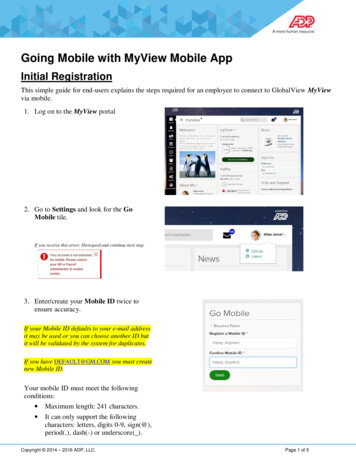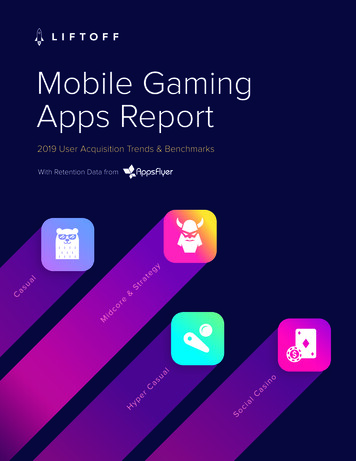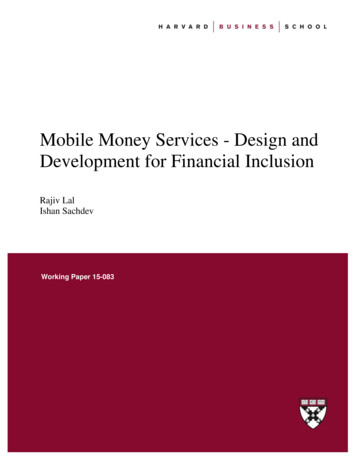
Transcription
Mobile Money Services - Design andDevelopment for Financial InclusionRajiv LalIshan SachdevWorking Paper 15-083
Mobile Money Services - Design andDevelopment for Financial InclusionRajiv LalHarvard Business SchoolIshan SachdevHarvard Business SchoolWorking Paper 15-083Copyright 2015 by Rajiv Lal and Ishan SachdevWorking papers are in draft form. This working paper is distributed for purposes of comment and discussion only. It maynot be reproduced without permission of the copyright holder. Copies of working papers are available from the author.
–Harvard Business SchoolJuly, 2015Professor Rajiv Lal, Stanley Roth, Sr. Professor of Retailing (rlal@hbs.edu)Ishan Sachdev, Research Associate (isachdev@mba2013.hbs.edu)We would like to thank the many individuals who have provided feedback on this paper throughout itsdevelopment, including Michael Joseph, Betty Mwangi, & Innocent Ephraim (Vodafone), Monica Brand(Accion Frontier Investments Group), Matu Mugo (Central Bank of Kenya), Tarun Khanna (HarvardBusiness School), Michael Tarazi (CGAP), and Ignacio Mas.1 P a ge
Table of Contents1.Introduction . 32.Structure of a Typical Mobile Money Service . 53.Key Competencies of a Successful Mobile Money Service . 74.Key Decisions Facing Mobile Money Operators & Regulators . 12Regulatory Structure. 13Corporate Structure. 21Business Model . 23Product Offering . 28Agent Network . 34Driving Adoption . 385.Conclusion . 436.References. 452 P a ge
1. IntroductionMobile money services are being deployed rapidly across emerging markets as a key tool to furtherthe goal of financial inclusion. Financial inclusion, the development of novel methods to enableindividuals at the base of the pyramid to access formal financial services and become part of the formalfinancial system, is considered a key pre-requisite for lifting these populations out of poverty and fordriving economic growth.There have been some notable successes, such as Vodafone / Safaricom’s M-Pesa in Kenya. Withinfive years of its launch, M-Pesa had 15 million customers, equivalent to 37.5% of the country’spopulation, and was processing 10 billion annually. However, the success of mobile money servicesmore broadly has been limited – in its 2012 Mobile Money Adoption Survey of mobile money services inemerging markets targeting the unbanked, GSMA identified only 14 “sprinters,” or those services whichwere scaling rapidly, out of the 150 total such services. Even replicating successful services in additionalgeographies has proven challenging, including efforts by Vodafone to take the M-Pesa model to othercountries in which it operates, such as South Africa. In addition, mobile money operators do not seemto have, a-priori, a good sense for which factors will determine the ultimate success of a deployment.Yet, the pace of new deployments is only accelerating, and given these past results and the apparentchallenge in learning from them, it is likely that many new deployments will also prove less thansuccessful.Therefore, in this research, we analyzed an array of mobile money deployments from across theemerging markets to attempt to understand which characteristics are critical for the success of a mobilemoney service, particularly at launch. Our research covered five successful mobile money deployments– Telesom ZAAD in Somaliland, Dialog eZ Cash in Sri Lanka, Econet EcoCash in Zimbabwe, SMARTCommunications SMART Money in the Philippines, and Globe Telecom GCASH in the Philippines – andfive less successful deployments – Vodacom M-Pesa in South Africa, MTN m-money in Uganda, EkoFinancial Services in India, and the broader situations in Nigeria and Brazil.We performed our analysis by reviewing existing primary research on these deployments, in orderto understand how they were developed, structured, and implemented, and how those factorsimpacted their eventual success, or lack thereof. We then used our conclusions to develop a preliminaryframework to help prospective mobile money operators with the design and development of a de-novosystem. This framework lays out what we believe to be the key decisions mobile operators must make,and our perspectives on which paths will lead to the highest chance of success. [Note that our sourcescame primarily from the time period of 2011 to 2013 when detailed research on these services wasdone, so our conclusions are drawn from their state at those points in time. Although they might haveevolved since, to the best of our knowledge any such changes don’t impact the conclusions we reached,and we’ve added updates where significant structural changes have occurred.]3 P a ge
We found that many aspects of a mobile money service can likely be generalized and replicatedfrom country to country, and don’t need to be re-invented for each deployment, but also that there areimportant components which should be customized to fit the local context.Section Two explains the structure of a typical emerging-markets mobile money service focused onfinancial inclusion; Section Three presents our view of those competencies we believe mobile moneyoperators must develop to be successful; and Section Four presents our preliminary design anddevelopment framework – our view of the key decisions mobile money operators must make inattempting to build these competencies, the major alternatives they have for each decision, ourperspective on which of those options presents the highest chance of success, and supporting examplesfrom the research we reviewed.4 P a ge
2. Structure of a Typical Mobile Money ServiceThe mobile money services we analyzed have many similarities in the approach taken to servicedelivery. In this section, we will cover the standard structure of these mobile money services, in orderto provide context for the rest of the paper. This descriptions below are not intended tocomprehensively encompass all existing mobile money services, but to be broadly representative of allthose we have seen, and to the best of our knowledge, broadly representative of the majority of existingservices.Owner / Operator: Mobile money services are typically owned and operated by either a MobileNetwork Operator (MNO) or a financial institution (typically a bank). Each type of organization has itspros and cons, which we will discuss in more detail in Section 4. MNOs have the benefit of owning thecellular network, providing and having access to consumers’ mobile phones, and frequently have aphysical presence in the relevant communities, but typically do not have experience in developing ordistributing financial services, nor the regulatory ability to do so. In turn, banks have the benefit ofalready offering similar services to the banked population, but must partner with an MNO to accessconsumers’ phones, and must often develop new business models to succeed in lower incomepopulations. In general, the question of which type of company deploys mobile money services isdecided by regulators – in those countries in which MNOs are allowed to deploy their own mobilemoney services, they have tended to be the first movers, whereas in countries where they areprevented from doing so, banks have tended to be the first movers.Bank Account Operator: Money flowing through a mobile money service must typically be heldin a regulated account of some sort. In many situations, even when the service is operated by a nonbank, a regulated bank is used as a back-end provider to actually hold customer funds as a custodian.These funds typically cannot be intermediated by the bank or the mobile money operator, and are alsoremote from the bankruptcy of the mobile money operator; however, the applicability of depositinsurance protections varies from country to country. In addition, any interest accruing on such fundstypically can’t be passed through to account holders (although Tanzania recently became the firstcountry to allow such an arrangement).Services Offered: Mobile money services typically offer a subset of the following services – Peerto Peer money transfers (P2P), remittances (domestic and / or international), bill payment / receipt,salary disbursement / receipt, retail payments, and money storage / savings. Of these, P2P tends to bethe most common offering. In addition, services offer methods for turning physical cash into electronicfunds in a customer’s mobile account (also called “cash-in”) and methods for turning electronic fundsinto physical cash (also called “cash-out”).Service Delivery Method: Mobile money services are typically delivered in one of two ways –either directly through a customer’s mobile phone or Over-the-Counter (OTC). Services delivereddirectly through a customer’s phone require the customer to put cash into their mobile account (i.e.5 P a ge
convert it into electronic form), which they can then use to make payments or transfers directly throughtheir phone. Services delivered OTC require the customer to physically visit a representative of themobile money operator, where the customer provides cash for transactions to the representative, whothen uses his / her own mobile phone and mobile money account to effect the transaction and takes thecash. Many services offer customers both options.Distribution Network: Mobile money operators typically leverage an “Agent Network” todistribute their services to customers. Agents are typically either a) retail locations directly owned bythe Operator, b) existing merchants, generally small independent stores or sometimes chains, whichhave been signed up by the Operator, or c) a mix of both. To reach scale, however, most mobile moneyservices must eventually leverage outside merchants. In many cases, there is a hierarchy of agents, withlarger agents having responsibility for managing a pool of smaller agents. Agents are typically located inclose proximity to the customers they will serve, and provide services including account registration,cash-in / cash-out, and OTC transactions, in addition to potentially helping market the service andeducate customers. Thus, agents are the primary way in which customers interact with the system.Customers Served: Mobile money operators typically require at least one party in a transactionto be a customer of the service (i.e. they must have an account with the operator), however servicesdiffer in whether they require both parties to be customers (e.g. whether a customer can send a P2Ptransfer to a non-customer).Fee Structure: There are many different fee structures employed by mobile money services,however they are typically all a) transaction-based (i.e. fees charged on a per-transaction basis), and b)involve fees charged to consumers. Transactions can include both transfers to others (e.g. P2Ptransfers), or cash-in / cash-out. Services typically set fees in order to encourage different behaviorsthey believe will be beneficial to their service – i.e. charging higher fees for cash-out vs. cash-in, toencourage customers to put money into the system, or charging higher fees to individuals who are notregistered users, to encourage them to become customers.6 P a ge
3. Key Competencies of a Successful Mobile Money ServiceIn this section, we will describe several key competencies which the mobile money services weanalyzed needed to develop in order to succeed. We divide these key competencies into two categories– those which we believe mobile money operators (or their parent companies) can build, and thosewhich we believe are much harder to develop if they don’t already exist within the parent company.However, we make no particular recommendation here as to which entity in a mobile money ecosystemmust develop the competency – and in fact there are multiple possibilities – the broader point beingthat each competency must exist somewhere within the system.Competencies Which Can Be DevelopedBuilding An Effective Working Relationship With Regulators: Regulatory oversight, or the lackthereof, is an important aspect of any mobile money service, as frequently there are no pre-existingregulations which directly address mobile money services. [Note that there can be multiple regulatorsinvolved in the regulation of mobile money, the most common being financial and telecommunicationsregulators. For the remainder of this paper, however, we will use “regulator” to mean financialregulators, as they typically have primary oversight responsibility for mobile money services.]Why is this critical? Any company which wants to operate a mobile money service will need to builda relationship with the relevant regulators in order to ensure that it can operate a mobile money servicewithout breaking any
consumers’ phones, and must often develop new business models to succeed in lower income populations. In general, the question of which type of company deploys mobile money services is decided by regulators – in those countries in which MNOs are allowed to deploy their own mobile money services, they have tended to be the first movers, whereas in countries where they are prevented from .
